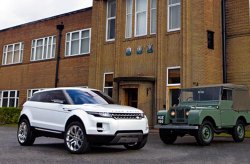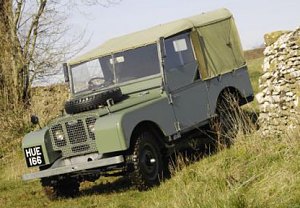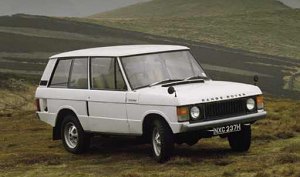
| - |
Production plant: Solihull (Range Rover, Discovery, Defender), Halewood (Evoque, Discovery Sport), Changshu (China, JV with Chery) (Evoque).

FY2019/20: 368,066 units
FY2018/19: 398,717 units
FY2017/18: 439,749 units
FY2016/17: 431,161 units
FY2015/16: 427,122 units
FY2014/15: 385,279 units
FY2013/14: 350,554 units
FY2012/13: 314,250 units
FY2011/12: 260,394 units
FY2010/11: 190,628 units
FY2009/10: 146,564 units
2007: 226,395 units
FY2020/21 sales by models:
Evoque: 68,571 units
Discovery Sport: 64,519 units
Discovery: 19,109 units
Defender: 45,244 units
Velar: 37,880 units
Range Rover Sport: 64,197 units
Range Rover: 42,399 units
Reference:
https://www.jaguarlandrover.com/investor-relations
During the years owned by Ford, LR had its R&D and many operations integrated with Jaguar to save costs. Therefore both companies were tied as a bundle and sold to the Tata group of India.
 1948 Land Rover Series 1
1948 Land Rover Series 1In 1970, Land Rover became a marque rather than a model name as a second model was added to the range: Range Rover. This was the world's first luxury 4x4. It was powered by a Rover V8, drove through a permanent 4WD system and rode on all-independent suspensions. It retained the strong off-road ability of traditional Land Rover while offering superior driving comfort and a luxury interior. It changed the traditional perception of 4x4s. It was two decades ahead of its Japanese and American rivals like Toyota Land Cruiser, Mitsubishi Pajero and Jeep Grand Cherokee.
In 1989, the wide gap between Range Rover and Defender (now the new name of the original Land Rover) was filled with Discovery, which was less luxurious and more affordable than Range Rover.
 1970 Range Rover
1970 Range RoverHowever, entering 1990s, the Japanese started introducing "soft-roaders", which traded a large degree of offroad ability for on-road handling and ride comfort. They employed monocoque chassis in place of the rugged ladder frame chassis of traditional offroaders. Initially Land Rover did not take that seriously, but when it saw the Japanese opened a new market and outsold it, it had to follow the trend. The result was Freelander, the first Land Rover with monocoque chassis. Nevertheless, Land Rover had shown its weakness in adapting to new market trends. It started losing out in the competition to the Japanese in the following decade.
From a brand of Rover, Land Rover became a separate division when it went under the management of BMW during 1994-2000. Then it was sold to Ford. The latter merged its R&D and purchasing with Jaguar to save costs, so that they became an inseparable pair. In 2008, Ford was hit by financial trouble and sold both companies to Tata group.